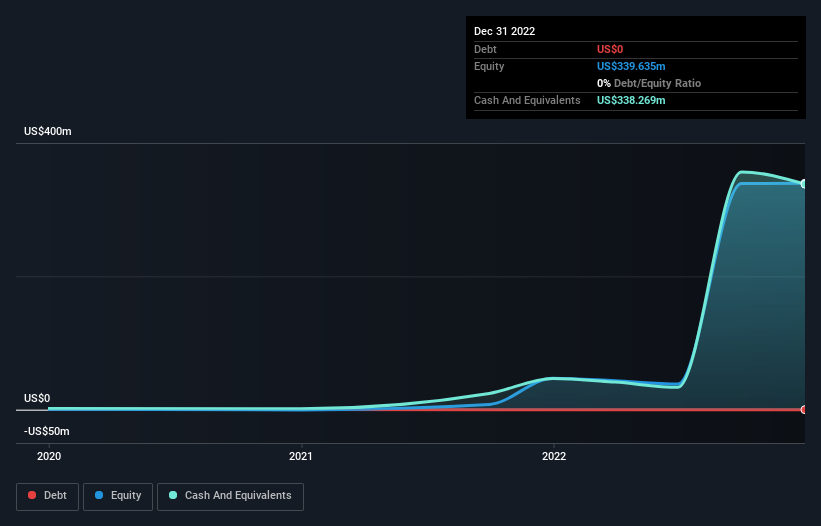[ad_1]
There’s no doubt that money can be made by owning shares of unprofitable businesses. For example, although Amazon.com made losses for many years after listing, if you had bought and held the shares since 1999, you would have made a fortune. But while history lauds those rare successes, those that fail are often forgotten; who remembers Pets.com?
Given this risk, we thought we’d take a look at whether Rumble (NASDAQ:RUM) shareholders should be worried about its cash burn. For the purposes of this article, cash burn is the annual rate at which an unprofitable company spends cash to fund its growth; its negative free cash flow. First, we’ll determine its cash runway by comparing its cash burn with its cash reserves.
View our latest analysis for Rumble
When Might Rumble Run Out Of Money?
A company’s cash runway is the amount of time it would take to burn through its cash reserves at its current cash burn rate. As at December 2022, Rumble had cash of US$338m and no debt. Looking at the last year, the company burnt through US$41m. Therefore, from December 2022 it had 8.2 years of cash runway. Importantly, though, analysts think that Rumble will reach cashflow breakeven before then. In that case, it may never reach the end of its cash runway. You can see how its cash balance has changed over time in the image below.
How Well Is Rumble Growing?
It was quite stunning to see that Rumble increased its cash burn by 479% over the last year. Given that operating revenue was up a stupendous 316% over the last year, there’s a good chance the investment will pay off. In light of the data above, we’re fairly sanguine about the business growth trajectory. Clearly, however, the crucial factor is whether the company will grow its business going forward. For that reason, it makes a lot of sense to take a look at our analyst forecasts for the company.
How Easily Can Rumble Raise Cash?
We are certainly impressed with the progress Rumble has made over the last year, but it is also worth considering how costly it would be if it wanted to raise more cash to fund faster growth. Issuing new shares, or taking on debt, are the most common ways for a listed company to raise more money for its business. Many companies end up issuing new shares to fund future growth. By comparing a company’s annual cash burn to its total market capitalisation, we can estimate roughly how many shares it would have to issue in order to run the company for another year (at the same burn rate).
Rumble has a market capitalisation of US$2.5b and burnt through US$41m last year, which is 1.7% of the company’s market value. That means it could easily issue a few shares to fund more growth, and might well be in a position to borrow cheaply.
So, Should We Worry About Rumble’s Cash Burn?
As you can probably tell by now, we’re not too worried about Rumble’s cash burn. In particular, we think its revenue growth stands out as evidence that the company is well on top of its spending. Although we do find its increasing cash burn to be a bit of a negative, once we consider the other metrics mentioned in this article together, the overall picture is one we are comfortable with. There’s no doubt that shareholders can take a lot of heart from the fact that analysts are forecasting it will reach breakeven before too long. Taking all the factors in this report into account, we’re not at all worried about its cash burn, as the business appears well capitalized to spend as needs be. We think it’s very important to consider the cash burn for loss making companies, but other considerations such as the amount the CEO is paid can also enhance your understanding of the business. You can click here to see what Rumble’s CEO gets paid each year.
If you would prefer to check out another company with better fundamentals, then do not miss this free list of interesting companies, that have HIGH return on equity and low debt or this list of stocks which are all forecast to grow.
Have feedback on this article? Concerned about the content? Get in touch with us directly. Alternatively, email editorial-team (at) simplywallst.com.
This article by Simply Wall St is general in nature. We provide commentary based on historical data and analyst forecasts only using an unbiased methodology and our articles are not intended to be financial advice. It does not constitute a recommendation to buy or sell any stock, and does not take account of your objectives, or your financial situation. We aim to bring you long-term focused analysis driven by fundamental data. Note that our analysis may not factor in the latest price-sensitive company announcements or qualitative material. Simply Wall St has no position in any stocks mentioned.
Join A Paid User Research Session
You’ll receive a US$30 Amazon Gift card for 1 hour of your time while helping us build better investing tools for the individual investors like yourself. Sign up here
[ad_2]
Source link

